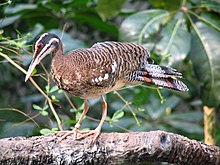Eurypygiformes
| Eurypygiformes Temporal range:
| |
|---|---|

| |

| |
| Scientific classification | |
| Domain: | Eukaryota |
| Kingdom: | Animalia |
| Phylum: | Chordata |
| Class: | Aves |
| Clade: | Eurypygimorphae |
| Order: | Eurypygiformes Hackett et al., 2008 |
| Families | |
Eurypygiformes /jʊərɪˈpɪdʒɪfɔːrmiːz/ is an order formed by the kagus, comprising two species in the family Rhynochetidae endemic to New Caledonia, and the sunbittern (Eurypyga helias) from the tropical regions of the Americas.[1] Its closest relatives appear to be the tropicbirds of the tropical Atlantic, Indian, and Pacific oceans.[2]
Classification
[edit]The affinities of Eurypygiformes are not very well resolved. The group consists of two families from a Gondwanan lineage of birds. Based on some morphological characteristics, they were initially classed as members of the family Ardeidae, and later the Gruiformes. According to Jarvis, et al.'s 2014 "Whole-genome analyses resolve early branches in the tree of life of modern birds", the group is distantly related to the Phaethontiformes.[2] The oldest known fossil eurypygiform is an indeterminate fossil eurypygid from the Early Eocene-aged Green River Formation of the United States.[3]
When seen as a gruiform, the kagu is generally considered related to the extinct adzebills from New Zealand and the sunbittern from Central and South America. Recent studies do indicate that the sunbittern is the closest living relative of the kagu. For example, Fain & Houde found these to be certainly sister taxa[4] and Furo et al. indicated a close phylogenetic relationship between them by cytotaxonomy; they suggest that their common ancestor was separated by the Gondwana vicariance in South America and New Caledonia, respectively.[5] They and the mesites did not group with traditional Gruiformes in their study, but instead with their proposed clade Metaves, which also includes the hoatzin, pigeons, Caprimulgiformes, flamingos, tropicbirds, Apodiformes, sandgrouse and grebes. The internal structure of this group was not well resolvable by their data, and contains numerous groupings not otherwise corroborated (such as Caprimulgidae and flamingos). The usefulness and monophyly of "Metaves" is therefore unclear. Notwithstanding, the kagu and sunbittern – and possibly the adzebills – seem to form a distinct Gondwanan lineage of birds, possibly one order, possibly more, even though the relationships between them, the mesites, and the "core Gruiformes" are not yet resolved. It is notable, however, that the sunbittern and the mesites possess powder down, whereas the "core Gruiformes" do not.
While the kagu is the only living species in the family Rhynochetidae, a larger species, the lowland kagu (Rhynochetos orarius), has been described from late Holocene subfossil remains. The body measurements of this species were 15% greater than Rhynochetos jubatus, with no overlap in measurements except those of the wings. Given that the sites where R. orarius has been found are all lowland sites, and that no fossils of R. jubatus were found in these sites, the scientists who described the fossils suggested they represented highland and lowland species, respectively. R. orarius is one of many species to have become extinct in New Caledonia after the arrival of humans.[6] The validity of the species has been questioned by some authors,[7] but accepted by others.[8]
Fossil Messelornithidae once included in Eurypygiformes are now considered the oldest known members of Ralloidea (Gruiformes).[9][10]
Species by global population
[edit]| Common name | Binomial name | Population | Status | Trend | Notes | Image |
|---|---|---|---|---|---|---|
| Kagu | Rhynochetos jubatus | 601-2,000[11] | EN[11] | Equal to 250-999 mature individuals.[11] | 
| |
| Sunbittern | Eurypyga helias | 500,000-4,999,999[12] | LC[12] | Estimate for mature individuals only.[12] | 
|
References
[edit]- ^ Hackett, Shannon J.; et al. (2008-06-27). "A Phylogenomic Study of Birds Reveals Their Evolutionary History". Science. 320 (5884): 1763–1768. Bibcode:2008Sci...320.1763H. doi:10.1126/science.1157704. PMID 18583609. S2CID 6472805. Retrieved 2008-10-18.
- ^ a b Jarvis, Erich D.; et al. (2014). "Whole-genome analyses resolve early branches in the tree of life of modern birds". Science. 346 (6215): 1320–1331. Bibcode:2014Sci...346.1320J. doi:10.1126/science.1253451. hdl:10072/67425. PMC 4405904. PMID 25504713. S2CID 52818555.
- ^ Mayr, Gerald (2022), Mayr, Gerald (ed.), "Phaethontiformes and Aequornithes: The Aquatic and Semi-aquatic Neaovian Taxa", Paleogene Fossil Birds, Cham: Springer International Publishing, pp. 117–152, doi:10.1007/978-3-030-87645-6_7, ISBN 978-3-030-87645-6, retrieved 2024-10-15
- ^ Fain, Matthew G.; Houde, Peter (2004). "Parallel radiations in the primary clades of birds" (PDF). Evolution. 58 (11): 2558–2573. doi:10.1554/04-235. PMID 15612298. S2CID 1296408. Archived from the original (PDF) on 2012-07-19. Retrieved 2012-04-28.
- ^ Furo, Ivanete de Oliveira; Monte, Amanda Almeida; Santos, Michelly da Silva dos; Tagliarini, Marcella Mergulhão; O´Brien, Patricia C. M.; Ferguson-Smith, Malcolm A.; Oliveira, Edivaldo H. C. de (2015-12-01). "Cytotaxonomy of Eurypyga helias (Gruiformes, Eurypygidae): First Karyotypic Description and Phylogenetic Proximity with Rynochetidae". PLOS ONE. 10 (12): e0143982. Bibcode:2015PLoSO..1043982F. doi:10.1371/journal.pone.0143982. ISSN 1932-6203. PMC 4666659. PMID 26624624.
- ^ Balouet, Jean C.; Storrs L. Olson (1989). "Fossil birds from Late Quaternary deposits in New Caledonia". Smithsonian Contributions to Zoology. 469 (469): 28–32. doi:10.5479/si.00810282.469.
- ^ del Hoyo, J. Elliott, A. & Sargatal, J. (editors). (1996) Handbook of the Birds of the World. Volume 3: Hoatzin to Auks. Lynx Edicions. ISBN 84-87334-20-2
- ^ Steadman, David (2006). Extinction and Biogeography in Tropical Pacific Birds. Chicago: University of Chicago Press. p. 158. ISBN 978-0-226-77142-7.
- ^ Gerald Mayr (2019). "Hypotarsus morphology of the Ralloidea supports a clade comprising Sarothrura and Mentocrex to the exclusion of Canirallus". Acta Ornithologica. 54 (1): 51–58. doi:10.3161/00016454AO2019.54.1.005. S2CID 202849094.
- ^ Alexander P. Boast; Brendan Chapman; Michael B. Herrera; et al. (2019). "Mitochondrial genomes from New Zealand's extinct adzebills (Aves: Aptornithidae: Aptornis) support a sister-taxon relationship with the Afro-Madagascan Sarothruridae". Diversity. 11 (2): 1–24. doi:10.3390/d11020024. hdl:2440/119533.
- ^ a b c d IUCN (2019-08-14). Rhynochetos jubatus: BirdLife International: The IUCN Red List of Threatened Species 2019: e.T22692211A156666402 (Report). doi:10.2305/iucn.uk.2019-3.rlts.t22692211a156666402.en.
- ^ a b c d IUCN (2019-12-04). Eurypyga helias: BirdLife International: The IUCN Red List of Threatened Species 2020: e.T22691893A163625651 (Report). doi:10.2305/iucn.uk.2020-3.rlts.t22691893a163625651.en.
